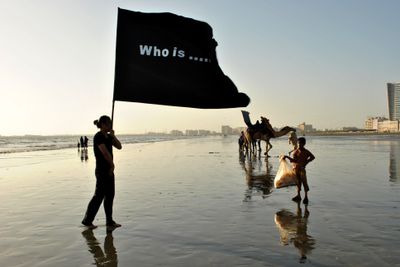By Herman Bashiron Mendolicchio
27 Apr 2017
Urbanities: Exploring Art and Public Space in Pakistan
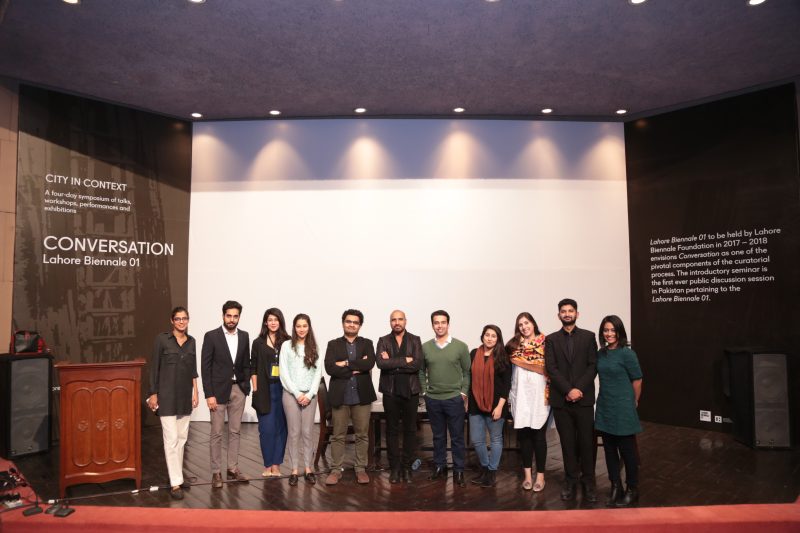
[caption id="attachment_63564" align="aligncenter" width="620"]
A series of key events, including workshops, research projects, artist residencies, performances, exhibitions and the final symposium ‘City in Context’ shaped the yearlong project entitled Urbanities.
Among the main objectives, there was the need to critically analyse and explore the complexities of urban and public space in Pakistan, both of which are in a constant process of contestation and renegotiation.
A high level of security barriers shaping public space, sectarian violence, gated communities, a significant density and diversity of population, and the perceptible presence of weapons are among the intricacies characterising this specific context.
What are the role and functions of art and culture when addressing such complex matters? How can art and culture explore, reshape and re-contextualise the use and meaning of urban and public space in Pakistan?
The project Urbanities, coordinated by Sara-Duana Meyer, addressed these initial questions through a series of events, including:
- A workshop on ‘Art and Law’, held in Lahore by digital pioneer Paul Keller.
- Artist Residency: Germany-based artists Honi Ryan and Miro Craemer, and Pakistani artist duo Shahana Rajani & Zahra Malkani were invited to engage with the cities of Karachi and Lahore as sites of urban exploration and artistic research. The residency projects were developed in collaboration with the Lahore Biennale Foundation and Vasl Artists' Collective in Karachi.
- Urban Design Research Project: Urbanities invited the German-Spanish collective zoohaus/Inteligencias Colectivas to carry out research focused on informal urban design. Two members of the collective, Juan Chacón Gragera and David Cardenas Lorenzo, explored and studied a specific area of Karachi -Pakistan Chowk- a public heritage landmark site, later presenting the documentation of their work at the Urbanities
- The symposium ‘City in Context’ and the Urbanities exhibition -both held in Lahore, at Alhamra Arts Council, Alhamra Arts Gallery and Annemarie-Schimmel-Haus, on December 1-4, 2016– were definitely the main events of the Urbanities
The symposium was opened by Stefan Winkler, Director of Goethe-Institut Pakistan, with Osman Khalid Waheed, Chairman of Lahore Biennale Foundation and brought together a diverse group of participants, including international and local artists, architects, urbanists, researchers and other cultural practitioners.
[caption id="attachment_63567" align="aligncenter" width="434"]
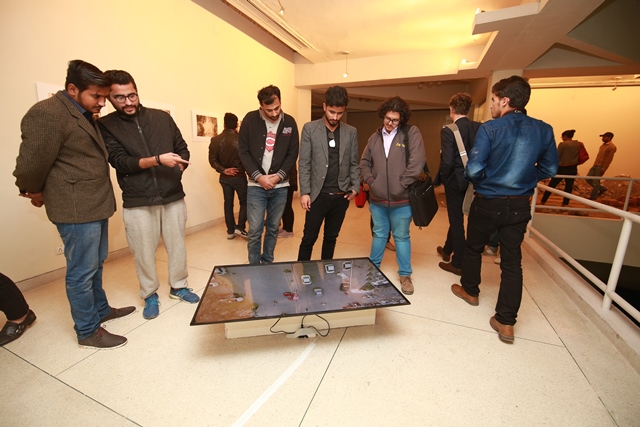 Honi Ryan, Walking Presence, 2016. Urbanities exhibition, Lahore[/caption]
Honi Ryan, Walking Presence, 2016. Urbanities exhibition, Lahore[/caption]The intense programme stimulated several critical discussions on a series of crucial questions identified by the organizers:
What does the “right to the city” mean in places where laying claim to urban space needs constant renegotiation, where occasional violence draws the borders of accessibility on the urban maps? How is the city being narrated? Who contributes to the urban discourse in contested spaces of various contradicting parallel realities? How can the demographics of a city be engaged and resettled and what can art do about it?
Key lectures and panel discussions addressed these and other questions, analysing local and international research and artistic projects.
[caption id="attachment_63561" align="alignright" width="353"]
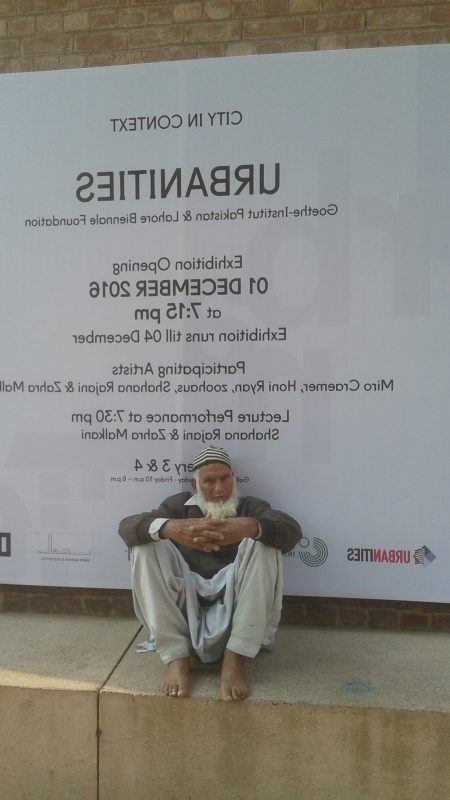 City in Context. Urbanities Symposium. Lahore, December 2016[/caption]
City in Context. Urbanities Symposium. Lahore, December 2016[/caption]The lecture by Kai Vöckler, urbanist and founder of Archis Interventions, focused on the practice of turbo-urbanism, illegal constructions and hybrid buildings, specifically speaking of the case of Prishtina, Kosovo.
In the panel discussion ‘Contested Spaces: Conflict, Violence, Reconciliation’, Adeela Suleman, founder of VASL Artists’ collective in Karachi, also argued the importance of trust, referring to accessibility, community ownership, and the ambiguous role of culture in reclaiming public space.
The expression “right to the city” encompasses several meanings that definitely change according to each context. Twenty-first century cities, which are increasingly inhabited by different ethnic, religious and cultural communities, struggle for a balance between shared rights and responsibilities. In view of this, a public space founded on trust and common needs can play an essential role in contrasting violence and conflict.
In the following panel, ‘Agency and Engagement: Urban Creative Practices’, Farida Batool, from Awami Art Collective, presented some of their public art projects in Lahore. The collective intervenes in public space for peaceful co-existence and the celebration of diversity. Their recent installation Black Spring consisted in a 2000m-long web of lights across the rooftops of the Walled City of Lahore’s historic centre. The installation, on the one hand, questions contemporary urban development projects, which do not consider the nature, ethos, culture, traditions and heritage of the ancient city; on the other, it functions as a criticism of the ban on Basant (the traditional kite-flying festival) that was once celebrated on the roofs of the old city to announce the coming of spring.
Other interventions included those by Matthias Einhoff, founder of the ZK/U –Zentrum für Kunst und Urbanistik in Berlin; Jochen Becker, from MetroZones, Center for Urban Affairs, Berlin; Omar Nagati, Cairo-based architect and urban planner; and the contributions of the different artists in residency, part of the Urbanities project: Miro Craemer, Zoohaus|Inteligencias Colectivas, Honi Ryan, Zahra Malkani & Shahana Rajani.
The walking performances, developed in Lahore by Honi Ryan were of artistic note. Her project Walking Presence, a series of silent walks, investigated the existence and manifestation of bodies in public space. Through silent walks, the performance activated awareness of places while mapping subjective geographies.
[caption id="attachment_63565" align="alignleft" width="423"]
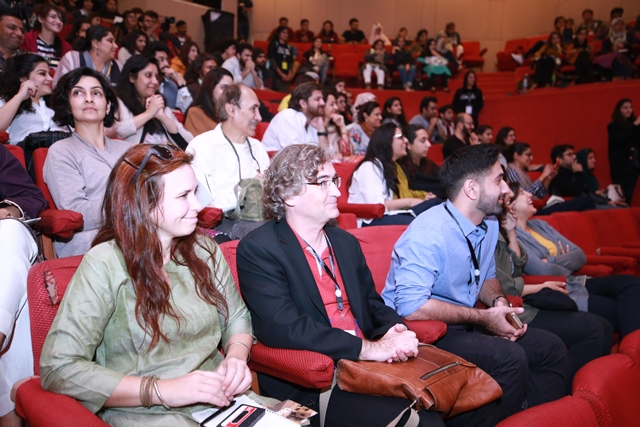 City in Context. Urbanities Symposium. Lahore, December 2016[/caption]
City in Context. Urbanities Symposium. Lahore, December 2016[/caption]Through his work Cord of Desires, Miro Craemer, artist in residency through VASL, Karachi, addressed the tragic Baldia Factory Fire of 2012. Based on research and interaction with the victims' families, the artist and social designer built a public installation in collaboration with students from the Indus Valley School for Art and Architecture, IQRA University North Campus, and local tailors.
It is important to underline that the entire symposium, in the framework of Urbanities, was interspersed with other activities, seminars, workshops and exhibitions organized by the Lahore Biennale Foundation. In view of this next big event, which is expected to activate the city of Lahore between 2017 and 2018, several art professionals from Pakistan and abroad contributed to the discussions and conversations. Among these, Rashid Rana (Artistic Director of the Lahore Biennale), Salima Hashmi, Adnan Madani, Quddus Mirza, H.M. Naqvi, Nav Haq and Haajra Haider Karrar stand out.
In brief, reflections on the future of urban and public space are definitely taking centre stage in the international cultural field. Shaping better spaces for the co-existence of current flows of diverse people inhabiting the shifting global landscape is an urgent topic that can be effectively tackled by art and culture.
[caption id="attachment_63571" align="alignright" width="389"]
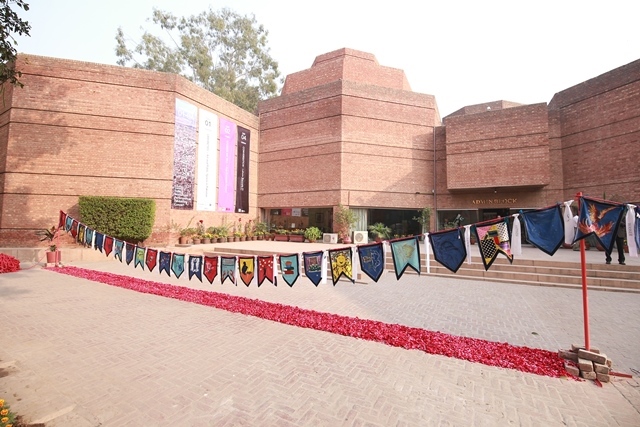 Miro Craemer, Cord of Desitres, 2016. Urbanities exhibtion, Lahore[/caption]
Miro Craemer, Cord of Desitres, 2016. Urbanities exhibtion, Lahore[/caption]Pakistan’s peculiarities indeed present several challenges, but its diverse layers of complexity can be better approached by the joining together of different perspectives, practices and practitioners.
The Urbanities project is a significant example of the need for cultural cooperation –at the local and international levels– in order to examine unexplored territories and learn about the vital importance of urban and public space.
Herman Bashiron Mendolicchio holds a European PhD in “Art History, Theory and Criticism” from the University of Barcelona. His current lines of investigation involve the subjects of intercultural processes, globalization and mobility in contemporary art and cultural policies, the interactions between artistic, educational, media and cultural practices in the Mediterranean and the cultural cooperation between Asia and Europe. He has participated in several international conferences and developed projects and research residencies in Europe, Asia and the Middle East. As an art critic and independent curator he writes extensively for several international magazines. He is special correspondent for ASEF culture360.
Similar content
posted on
10 Dec 2015
posted on
01 Dec 2020
posted on
15 Nov 2018
posted on
28 Mar 2011
posted on
07 Sep 2010
posted on
10 Jan 2014
